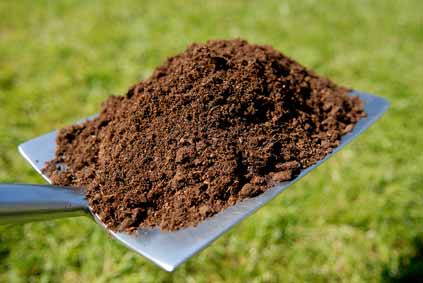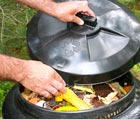- Gardening Tips |
- | What's NEW! |
- | Contact Us |
- | Sitemap
Soil Types - The Down and Dirty Facts
There are three main garden soil types you may find in your garden areas: sandy, clay-based, or loamy ... or any combination of the three.
The ideal garden soil texture is crumbly to allow:
- plant roots to move easily in
- air to pass through and water to drain at a moderate rate
A quick 'n easy way to determine what type of soil you have is to dampen some of your dirt and form it into a ball.

If it crumbles and falls apart when squeezed, you have a sand-based soil. If the dirt ball can be pressed between your fingers into a flat ribbon, you have a clay-based soil.
Sandy soils are a bit easier to work with than clay soils. Once flowers and plants are put into the ground, their roots can move a bit more freely in sandy soils.
The sandy soil will require more watering than other soils though.
Clay soils will need a little extra help in order to keep your garden areas productive once you've given them a healthy start.
Clay soils drain very slowly and are prone to water logging. Blue or grey clays need to be loosened to promote drainage. Red clays are looser and will drain well.
The third basic soil type, and the ideal texture for your garden soil, is the loamy type soil. If squeezed when wet, loam will form a rough, crumbly ball in your hand.
Loamy soil drains slowly enough for nutrients to get absorbed by plants and fast enough for air to move through the soil for root growth. If you're lucky to have beautiful, nutrient rich loamy soil, continue to feed and care for it well.
Gardening Tip:
When you are transplanting each flower or plant, take that time to improve / amend the soil by using at least a 10# bag of nutrient-rich humus soil for each plant. By using soil amendments in your garden, plant by plant and area by area, within a short space of time you will be improving your entire growing area.
For more detailed information about soil and soil types, be sure to check out
Improve Your Garden Soil. For a truly blossoming garden, learn how to make the most of your garden soil types.
Related Content:
To Top of this Soil Types page
Return to Gardening Tips Home Page
Gardening Updates
Note: We'd love you to send us your favorite garden pics to feature on our new pages!
Contact Us and we'll send you an email address that can accommodate your photographs.


The Comments Patch! - Add your off-shoots here: